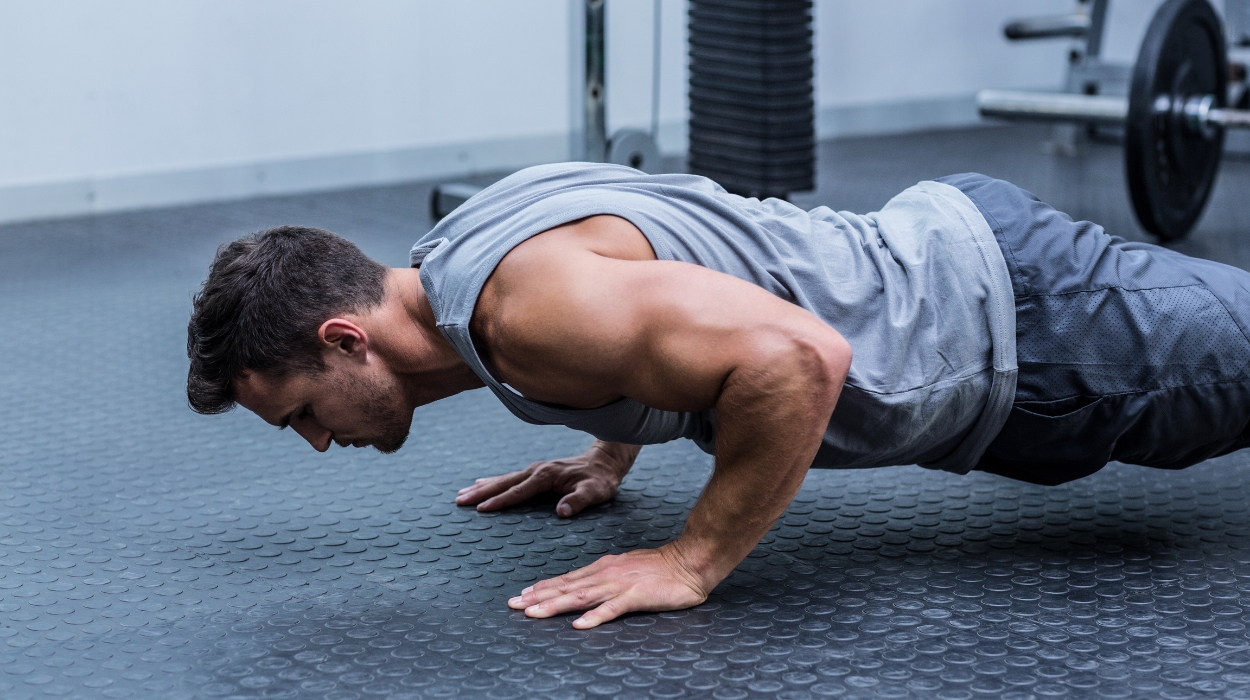
Starting a new fitness journey may bring up concerns about crowded gyms and complex weightlifting machines. However, an effective and sometimes overlooked alternative is calisthenics. The word calisthenics comes from the ancient Greek words kalos(beautiful) and stenos (strength) and embodies simplicity and power.
If you’re interested in a comprehensive calisthenics shoulder workout that improves your physique without any equipment, you can do so with just your body weight as resistance. The following article is an excellent resource for beginners seeking a refreshing new workout routine.
Read on to redefine your physical limits and gain a new perspective on your personal fitness as you learn new upper back exercises along the way.
Eight Best Shoulder Workouts Calisthenics
- Push-ups.
- Prone IYT.
- Shoulder Dips.
- Side Lateral Raise.
- Reverse Iron Cross Push-ups.
- Shoulder Tap Push Ups.
- Decline Pike Push-ups.
- Handstand Push-ups.
These exercises are convenient and versatile and are a great way to challenge your entire shoulder girdle. These calisthenics movements can be performed in the comfort of your own home and are a good alternative to classical dumbbells. These exercises
Best Calisthenics Shoulder Workout In 2024
A major benefit of calisthenics is that you need little, if any, equipment. If you find comfort in going to a traditional gym, you could give these shoulder exercises with dumbbells a try. However, the following exercises will focus on teaching you calisthenics shoulder exercises that you can perform at home with your own body weight.
Push-Ups
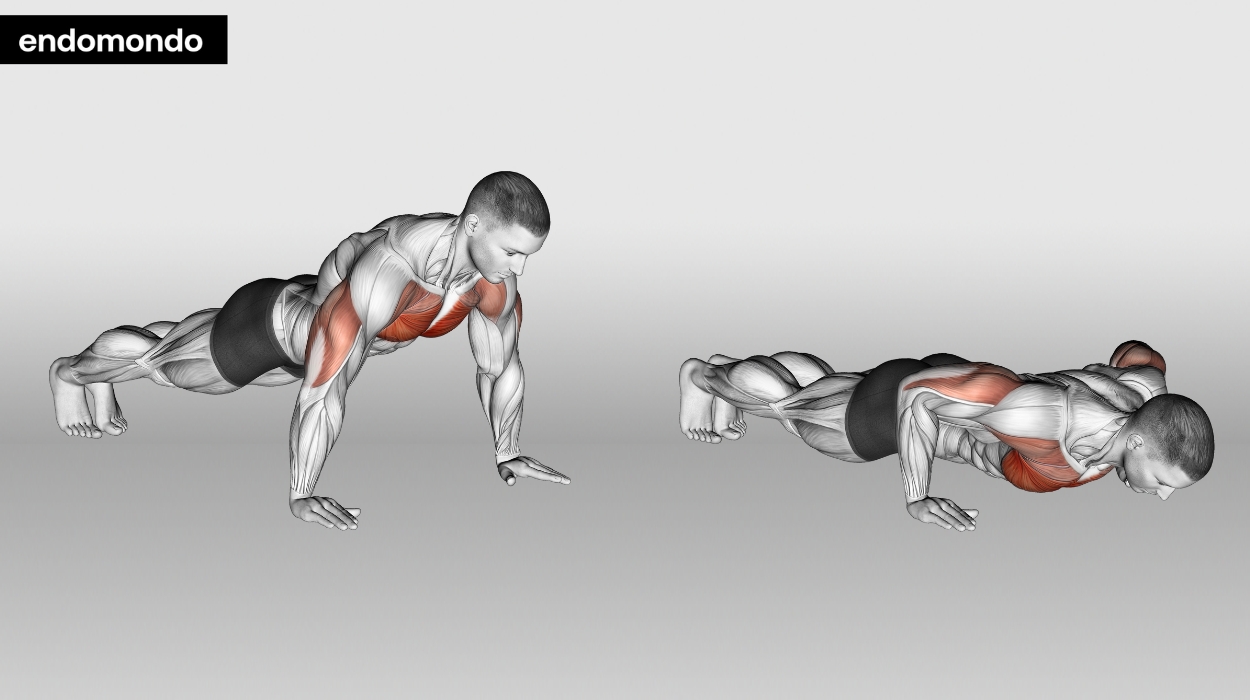
Push-ups are a fundamental and traditional exercise when it comes to calisthenics. It is a great way to strengthen your chest, deltoids, and triceps. You can progress to more challenging exercises such as handstand push-ups or pike push-ups. The best thing about this exercise is that you can easily modify it by changing your hand placement or trying knee push-ups.
How to do:
- Position your hands on the floor, just past shoulder-width apart.
- Extend your legs with your feet hip-width apart.
- Draw in your belly button and squeeze your butt muscles.
- Keep your back flat and slowly lower your body towards the floor.
- Exhale and push back to the starting position.
Tips:
- Maintain a straight line from your head to your heels.
- Engage your core by keeping it tight.
- Avoid fully locking out your elbows.
- Inhale as you descend.
Optimal Sets and Reps: Begin with a rep range suitable for your fitness level and gradually increase it as you get stronger. For building strength and hypertrophy, pushing yourself until you reach or are close to failure is generally recommended.
Take a break of 60 seconds and repeat the exercise for 2-3 sets.
Prone IYT

Another great exercise to target your upper back muscles is the Prone IYT. IYT refers to a configuration of movements used to create the letters IYT.
This exercise targets the shoulder muscles and the entire shoulder girdle. It’s a movement pattern that can improve overall shoulder mobility and lead to healthy shoulders.
A great benefit of this exercise is that you can easily perform it on a floor or use a medicine ball to challenge your core further.
How to do:
- Lie down face flat on the floor, on an incline bench, or on a stability ball.
- Extend your arms straight in front of you.
- Slowly lift your arms straight up to form an “I.”
- At a slight angle, diagonally, move your arms out into a “Y.”
- Move your arms horizontally, creating a 90-degree angle so you are forming a “T.”
- Hold each pose for 1 second and return to the resting position.
Tips:
- Keep your head and neck in a neutral position.
- Point your thumb up when performing the I and Y.
- Keep your palms facing downward when performing the T.
Optimal Sets and Reps:
Aim for 8-12 repetitions in each direction. A simple way to perform this activity is to create eight forward I’s, eight slightly angled Y’s, and then eight horizontal T movements.
Rest for 60 seconds and repeat for 1-2 more sets.
Shoulder Dips
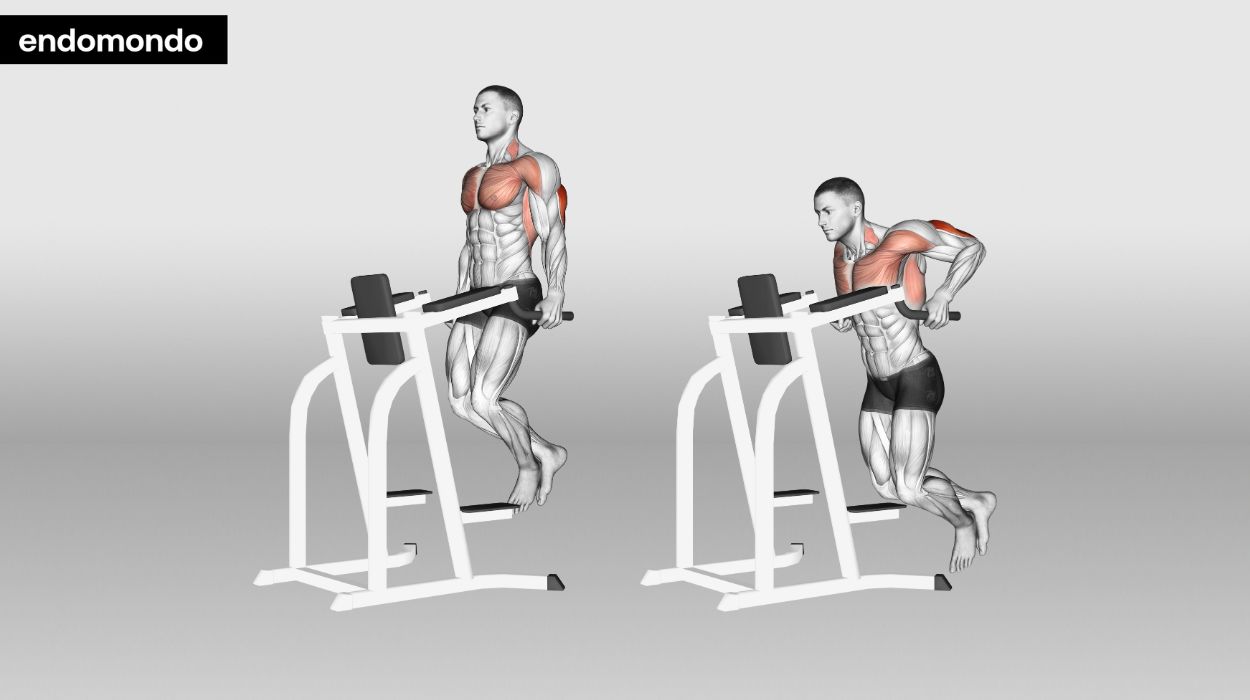
Shoulder Dips are a versatile and dynamic exercise used to target the front delts, triceps, core muscles, and upper chest. It can easily be modifiable with a bench, chair, or platform to decrease the intensity.
If you’re looking for more of a challenge, consider adding weight belts or progressing to Olympic rings for added instability. This is a true upper-body strength challenge that will promote balanced muscle development in your shoulders.
How to do:
- Grip a parallel bar or dip machine with your hands facing inward.
- Raise your feet off the floor and bend your knees as you lift your body upwards.
- Bend your elbows as you lower your body until your shoulders are slightly below your elbows.
- Push through your palms to lift your body upwards back to the starting position.
Tips:
- Maintain an upright position to target the shoulders correctly.
- Start with a partial or small range of motion at first to get accustomed to the movement.
- Do not lock out your elbows at the top of the movement.
Optimal Sets and Reps:
Choose a set and rep range that you’re most comfortable with. Studies[1] have shown a broad range of reps and sets that can lead to muscle growth or hypertrophy.
This flexibility in optimal range allows you to have more control in modifying your workout. So focus on challenging yourself and selecting a resistance that brings you close to failure, with about three to four repetitions left in reserve.
Bodyweight Side Lateral Raise
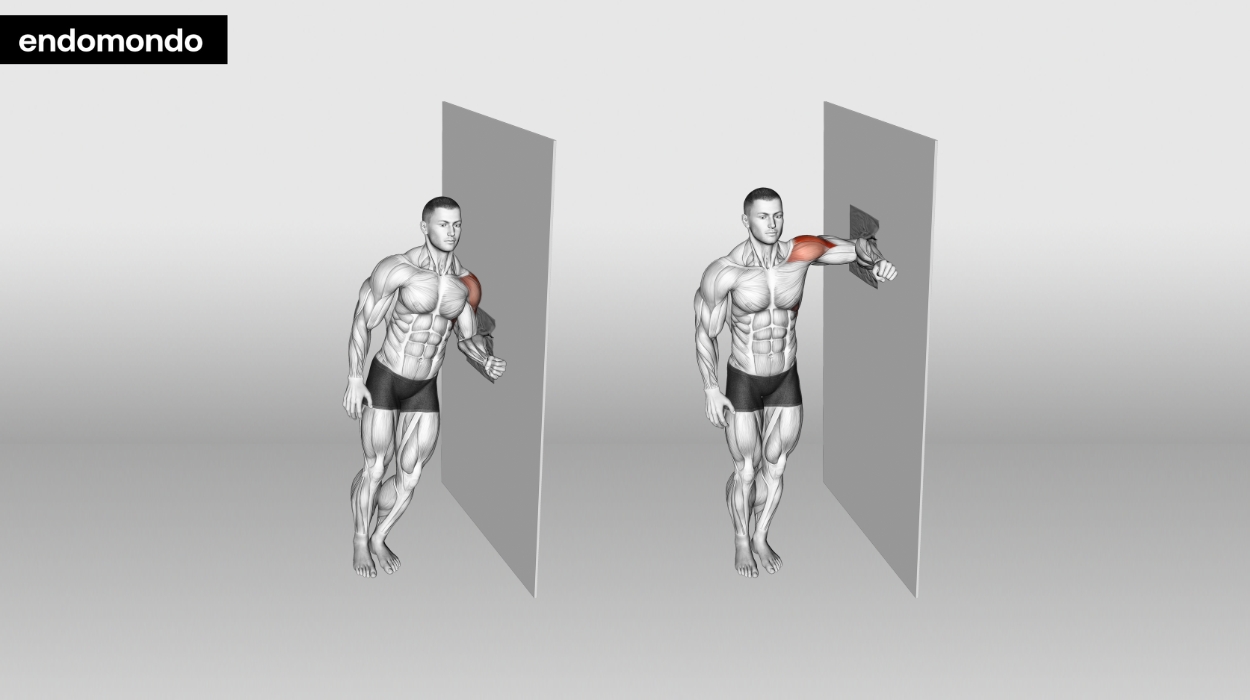
The Dumbbell Side Lateral Raise is a classic exercise that primarily targets the medial deltoid of the shoulder. An alternative to this activity that doesn’t require any weights is the Bodyweight Side Lateral. This exercise achieves a loaded abduction of the shoulders and is a great way to build strength and stability in your shoulders. It even targets your obliques and core muscles.
How to do:
- Lie on the floor in a standard plank position.
- Keep one arm pressed into the ground on your forearms with weight on your elbow.
- Rotate your upper body as you twist to the left and up, raising your opposite arm.
- Hold for one count.
- Slowly return to the starting position.
- Repeat on the other side.
Tips:
- Make sure you pivot at the shoulder joint.
- Keep your core muscles tight as you twist your torso.
- Put padding under your elbows if the weight bothers them.
Optimal Sets and Reps:
Start small and work your way up as you get familiar with the movement pattern. A good approach could be 2-3 sets for 6-10 reps.
Reverse Iron Cross Push-Ups
Moving on to the posterior deltoids is a unique exercise that you might not be familiar with. The supine reverse iron cross is a challenging exercise that simulates a push-up from lying on your back. The rear delts can be difficult to target and are often trained with a combination of cable workouts; this simple yet effective exercise will do wonders for your shoulder width.
How to do:
- Lie on your back with your feet flat on the ground, knees bent, and feet shoulder-width apart.
- Extend your arms out to your sides so that you are forming a ‘T’.
- Close your fists, pushing them into the floor as you raise your chest off the ground.
- Raise your upper back enough so your elbows clear the floor.
- Hold the contraction for a full second.
- Slowly return back to the starting.
Tips:
- Focus on pushing through your fists.
- Avoid tightening your core muscles or flexing at the trunk.
- Exhale as you raise your chest up.
Optimal Sets and Reps:
Find a comfortable range for you. Beginners might find that three sets of 5-8 repetitions are a good starting point. A rep range of 8-12 could be more suitable for intermediate to advanced lifters.
Shoulder Tap Presses
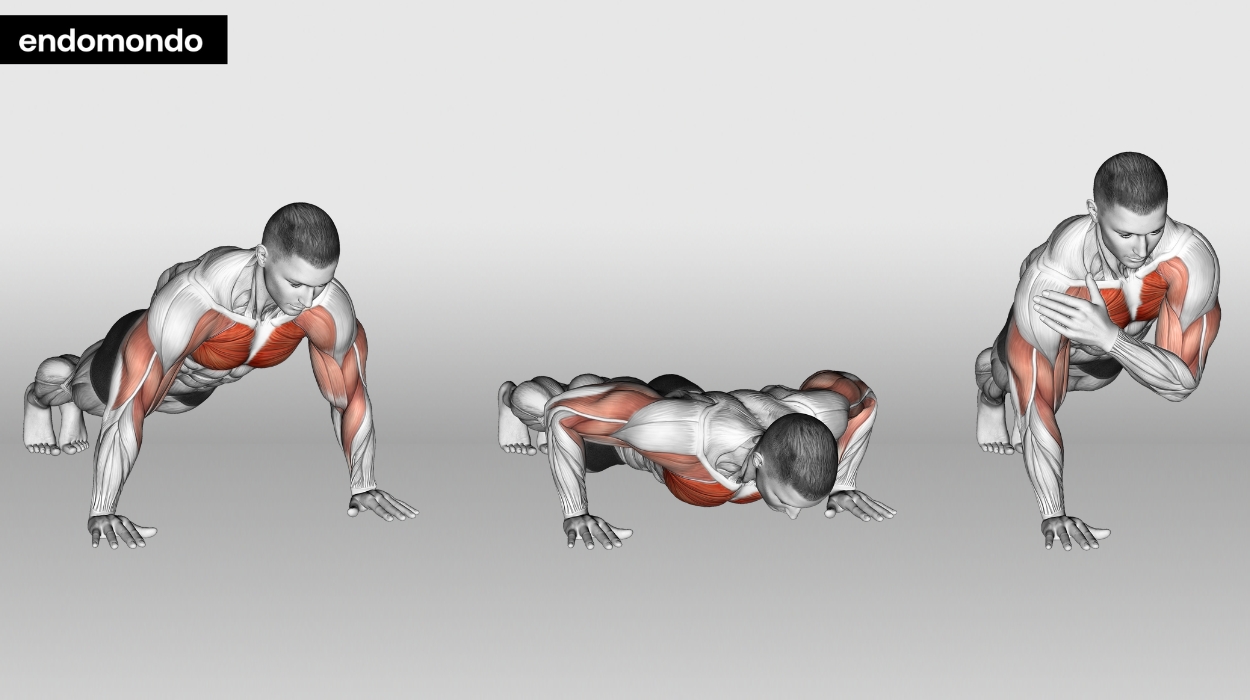
Shoulder Tap Presses have a great functional carryover and are a great alternative to loading your anterior deltoid without the use of kettlebells or dumbbells.
How to do:
- Begin in a plank position with your arms shoulder-width apart.
- Maintain a straight back from your head to your heels.
- Alternatively, lift one hand to tap the opposite shoulder while maintaining a stable core.
- Hold for a one-second count.
- Perform a push-up after each tap for an extra challenge.
- Repeat with the opposite hand.
Tips:
- Keep your hips level, and avoid excessive rocking.
- Engage your core throughout to stabilize your body.
- Improve your shoulder strength by increasing the shoulder tap for 2-3 seconds.
Optimal Sets and Reps:
Beginners might find that three sets of 5-8 repetitions are a good starting point. A rep range of 8-12 could be more suitable for intermediate to advanced lifters.
Decline Pike Push-Ups
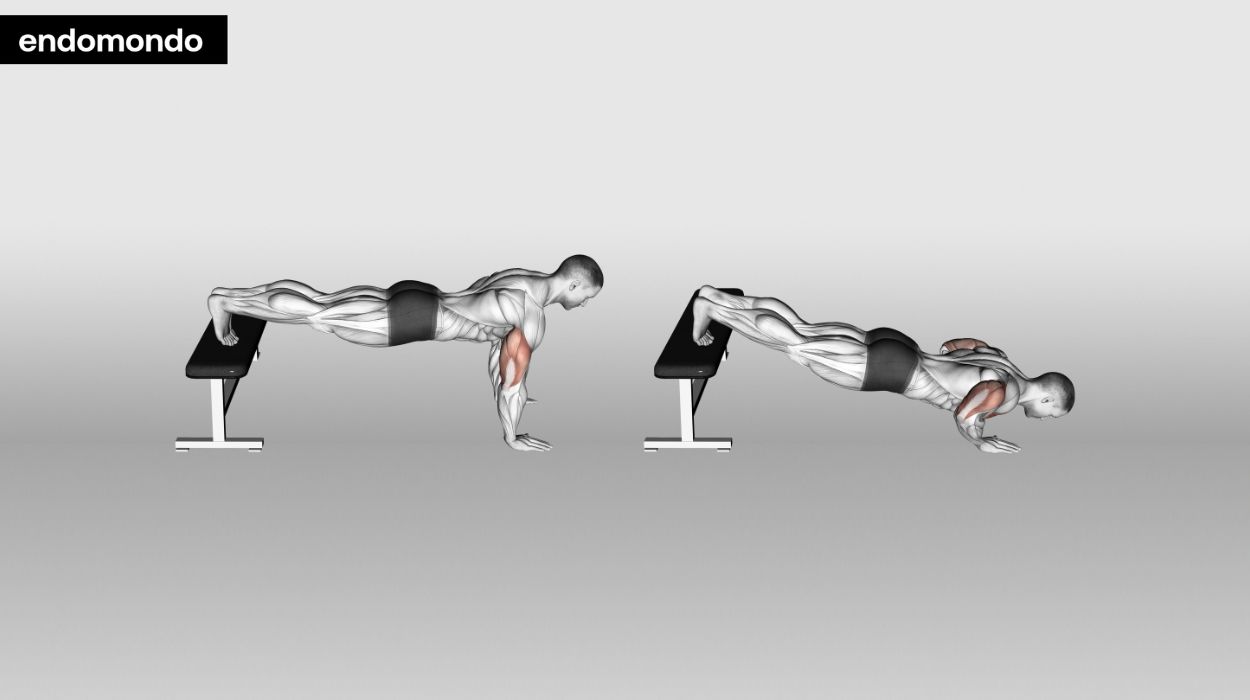
Performing Pike Push-ups is a challenging, intermediate-level exercise that is a great stepping stone for more advanced exercises. Decline Push-ups aim to simulate a shoulder press movement and target the anterior deltoid. It’s a perfect addition to any push-day workout routine.
How to do:
- Assume a decline plank position with your feet supported on a chair or bench with weight on your toes.
- Hinge at your hips, forming a straight line with your body.
- Perform a feet-elevated Pike Pushup by lowering your chest to the ground.
- Push up to the starting position maintaining straight arms but not locked elbows.
Tips:
- Ensure a sturdy platform for your feet.
- Focus on a controlled descent and ascent.
- Gradually increase the decline for added intensity.
Optimal Sets and Reps:
Adjust based on your fitness level and aim for a challenging but manageable workload. Beginners can aim for 1-2 sets of 6-10 repetitions. Aim for 20-25 reps for 2 sets for a more advanced workout.
Handstand Push-Ups
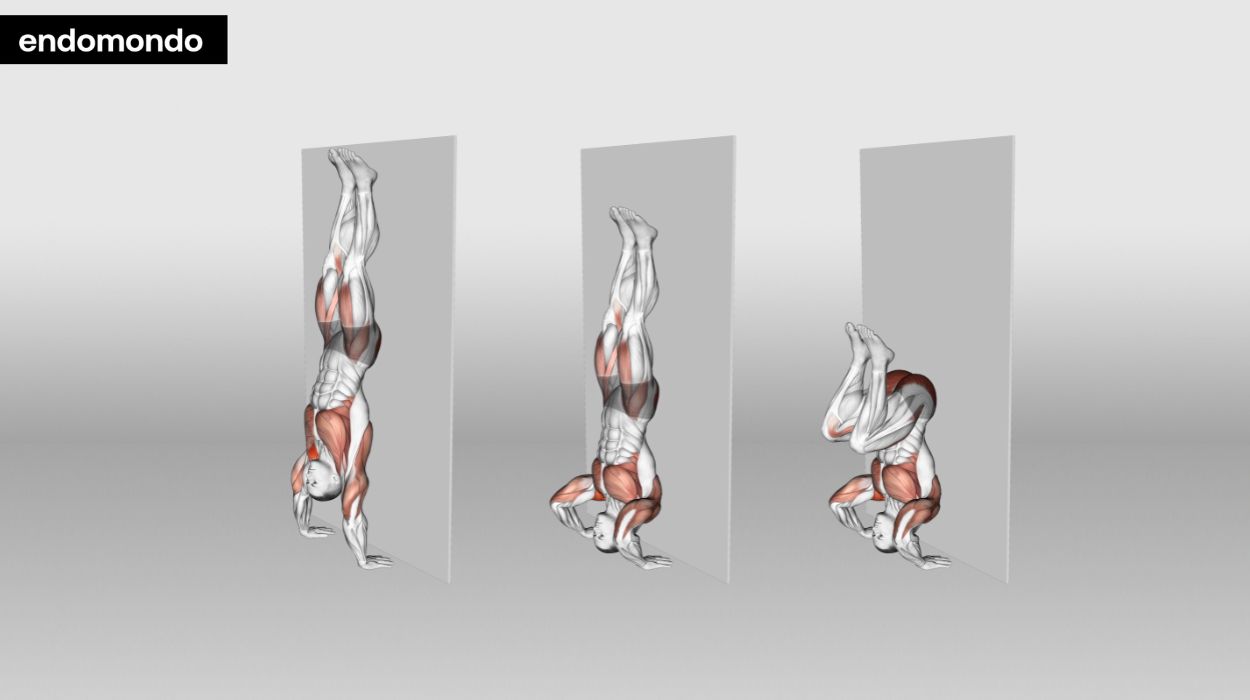
Elevate your shoulder gains with a Handstand Push-up. The last exercise on the list is also the most intense and requires a high level of balance, strength, coordination, and stability. Inverted and against gravity, the handstand position targets your deltoids, triceps, and upper back for a balanced workout as you perform these shoulder calisthenics.
How to do:
- Position yourself in a straight handstand. Beginners may use a wall with their belly facing the wall.
- Slowly let yourself down as you move your shoulder forward, maintaining a slight angle in your back.
- Point your elbows backward as you keep your body straight.
- Once you reach the bottom, push yourself back up to the starting position.
- Take a moment to find your balance at the top of the movement.
- Repeat for the desired number of sets and reps.
Tips:
- Use a spotter who can help guide your legs or perform against a wall.
- Gradually increase reps as your strength improves.
- Keep your core tight, as maintaining proper form is crucial.
- Avoid arching the lower back or letting your body get horizontal.
Optimal Sets and Reps:
This is a very intense exercise. Therefore, aim for 1-2 reps if you’re just starting out, then progress to higher reps based on your fitness level.
What Exactly Are Shoulder Calisthenics?
A calisthenic shoulder exercise is a form of exercise that mainly relies on using body weight as resistance. These exercises often involve dynamic movements that require a combination of shoulder stability movements.
Benefits Of Shoulder Calisthenics Exercises
Strength Building
Incorporating a calisthenics workout into your routine can effectively target your upper-body muscles and improve your overall strength. In fact, studies have shown that performing calisthenics exercises[2] can be just as effective as traditional bench press training for building upper-body muscle mass and strength. The functional aspect of a lot of calisthenics workouts translates well in real-world situations.
Postural Endurance
Shoulder calisthenics can significantly improve posture by strengthening the stabilizing muscles surrounding the upper back, neck, and shoulder blades. Exercises such as shoulder taps, dips, and lateral raises promote balanced and well-rounded shoulders. This increase in strength can translate directly to longer postural positions when sitting, standing, or performing other work-related tasks.
Convenience
Studies have shown that calisthenics is a great alternative[3] to classical resistive training exercises that require dumbbells or other equipment. The benefits of calisthenics are that they are versatile, convenient, and a time-efficient way to improve health outcomes[4] such as blood pressure, hemoglobin A1c, and body composition.
Conclusion
This calisthenics shoulder workout offers a dynamic path to strength, flexibility, and sculpted shoulders all with the simplicity of bodyweight movements. Whether you’re a beginner venturing into fitness or just looking to avoid hectic gym crowds, these exercises redefine traditional workouts.
Calisthenics is a popular workout option due to its convenience and versatility. Incorporate these shoulder exercises into your routine to improve your fitness, protect against disease,[5] and achieve your desired physique without needing elaborate gym equipment.
Frequently Asked Questions
Yes, calisthenics are a great way to improve shoulder strength with bodyweight movements. Calisthenics challenges your shoulder stability, coordination, and balance.
Yes, while weights are common to include in your arm and shoulder workout, they are not necessary to load and challenge your shoulders.
Prone IYT and Reverse Iron Cross Push-ups are the most specific exercises to target your rear delts and build strong shoulders.
Even though pull-ups primarily target the latissimus dorsi, the largest muscle in your back, they also target the rhomboids and posterior deltoids. Pull-ups are an excellent choice for back development and offer a comprehensive upper-body workout.
Resources
- Krzysztofik, M., Wilk, M., Grzegorz Wojdała and Artur Gołaś (2019). Maximizing Muscle Hypertrophy: A Systematic Review of Advanced Resistance Training Techniques and Methods. International Journal of Environmental Research and Public Health, [online] 16(24), pp.4897–4897. doi:https://doi.org/10.3390/ijerph16244897.
- Kotarsky, C.J., Christensen, B.K., Miller, J.S. and Hackney, K.J. (2018). Effect of Progressive Calisthenic Push-up Training on Muscle Strength and Thickness. The Journal of Strength and Conditioning Research, [online] 32(3), pp.651–659. doi:https://doi.org/10.1519/jsc.0000000000002345.
- Hollingsworth, J.C., Young, K.C., Abdullah, S.F., Wadsworth, D.D., Abukhader, A., Elfenbein, B. and Holley, Z. (2020). Protocol for Minute Calisthenics: a randomized controlled study of a daily, habit-based, bodyweight resistance training program. BMC Public Health, [online] 20(1). doi:https://doi.org/10.1186/s12889-020-09355-4.
- Kamat, K., Kage, V. and Sequeira, S. (2023). Calisthenics versus Pilates training on glycemic control and body fat in overweight individuals with type 2 diabetes mellitus. Physiotherapy Practice and Research, [online] 44(2), pp.99–108. doi:https://doi.org/10.3233/ppr-220688.
- Neslihan Duruturk, Hulya Arıkan, Ulubay, G. and Mustafa Agah Tekindal (2015). A comparison of calisthenic and cycle exercise training in chronic obstructive pulmonary disease patients: a randomized controlled trial. Expert Review of Respiratory Medicine, [online] 10(1), pp.99–108. doi:https://doi.org/10.1586/17476348.2015.1126419.




